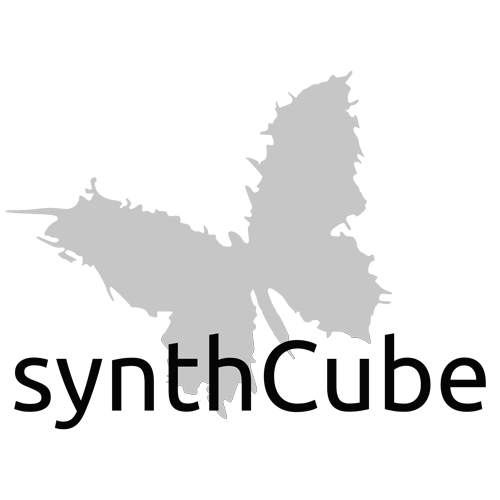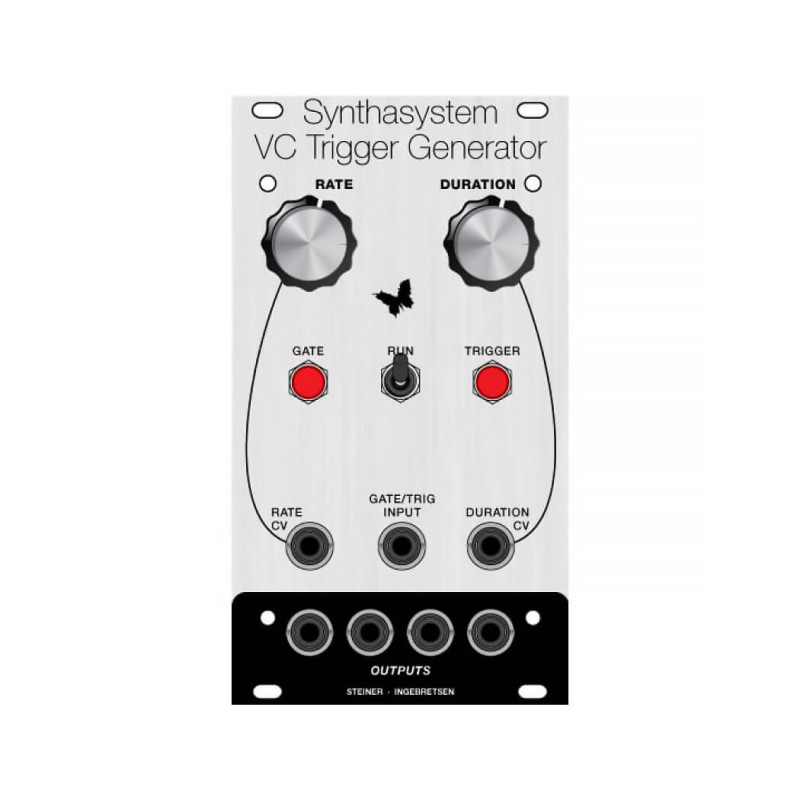Synthasystem VC Trigger Generator
Synthasystem VC Trigger Generator
The Synthasystem VC Trigger Generator is a classic module from the Steiner Synthasystem. This triggered generator module creates a train of triggers/gates whose frequency can be set manually or controlled by an external voltage. The duration of each trigger/gate can also be set manually or controlled by an external voltage.
You can use this triggered generator to create a single trigger manually or a train by pushing and holding down the appropriate button.
S-Triggers/Gates vs. Voltage Triggers/Gates:
Traditionally, a trigger is a short duration pulse which starts or synchronizes some other event, and a gate is traditionally associated with a key down event and can be of arbitrary length. A gate, too can synchronize or initiate an event, but can also maintain the state of some other module until it is released. For example, the Triple EG, type ENVDL, will maintain the Duration level while a gate is active on the input.
Steiner modules use S-Triggers/Gates by design. This re-issue adds the ability to build these modules to use Voltage Triggers/Gates.
S-Triggers are typically “floating” and then drop to a ground potential when active. Electrically, an S-Trigger is connected to the collector of an NPN transistor. The emitter of the transistor is connected to ground. When the transistor is off, the collector floats; an “open” collector. When the transistor is on, the collector to emitter creates a low resistance path to ground. In some cases (often in the re-issue designs) the collector is connected through a resistor to +12 volts. When the transistor is off, no trigger/gate, the collector (output) is effectively at a 12 volt potential. When on, the collector is at ground potential as without the pull-up resistor.
The advantage of S-Triggers/Gates is that multiple outputs can be tied together without fear of damaging the circuit when one output is active. That is, you can “OR” the outputs together without any additional circuits. This means that a trigger input can be connected to multiple trigger sources. On the sequencer, the “Clock In” can also be a “Clock Out”. You can’t do this with Voltage Trigger/Gate outputs. If you do, you will likely damage the output stage of the other connected outputs. You have to have some type summing buffer to do that.
Most modern equipment (all of it probably) uses Voltage Trigger/Gates. The trigger/gate is active when there is a positive voltage present. Most of the equipment I’ve seen will respond as soon as a minimum level is reached, typically 5 volts. To be compatible with modern equipment, I added a simply conversion circuit to the PCBs on all the trigger ins/outs so you can choose which to use. The way they are added, you can keep both if you want to.
From the Synthasystem Manual:
Triggers are the command signals of the system and are electronically equivalent to a grounding switch. See figure #20 part A for a graphic representation of this analogy.
Two or more trigger sources can be connected together in parallel, or as computer designers say, “WIRE ORED” together.
Triggers can be of any length in duration, from very short to very long. The STEINER-PARKER Basic Studio and Synthasound units typically produce and use triggers ranging from a few 1/1000ths of a second to greater than ten seconds. Whereas some of the modules requiring a trigger input do not care whether the trigger is short of long (such as the S&H and the sequencer input), other modules requiring a trigger input are sometimes controlled by the trigger duration (such as the envelope generator).
Two trigger sources connected in parallel are like two switches in parallel. When one trigger source is ON, the other had no effect. Therefore, one trigger source can act as an inhibitor to recurring triggers from another trigger source. See figure #20, part C.
The trigger generator can produce triggers of varying duration and rate. The rate is controlled by the rate knob and or a voltage fed into the V.C. Rate Jack. Trigger duration is controlled with the Duration Knob and or voltage fed into the V.C. Width jack.
The trigger gen can be made to run in one of three ways.
- Put the free run switch to the RUN position (up).
- Push the button marked GATE while the free run switch is in the OFF (down) position.
- Finally, you can feed a long trigger into the jack called position. The generator will run for the duration of the input trigger.
Iin this mode, manual triggers can be generated by pushing a button marked Man. Trig. The trigger duration in this case is continuous for as long as the button is pushed.
The trigger generator output is connected to four output jacks in parallel to facilitate ease of patching.
Here is what this looks like.
Inputs/Outputs:
This module has 3 inputs and 1 output.
1. VC Rate – A voltage here will control the rate and is summed with the Rate knob.
2. Trig/Gate – A trigger/gate here will cause the Trigger Generator to run while this input is active.
3. VC Duration – A voltage here will control the duration or width of the trigger
4. Trigger Outputs – 4 jacks in parallel for outputs
PCBs courtesy of David Ingebretsen from his faithful reproduction from the original schematics.
Aluminum Eurorack panel by Clarke Robinson, 14hp.
The full DIY synth kit includes everything you need to assemble and run the module.
| Module Parameters | |
| Format | Eurorack |


